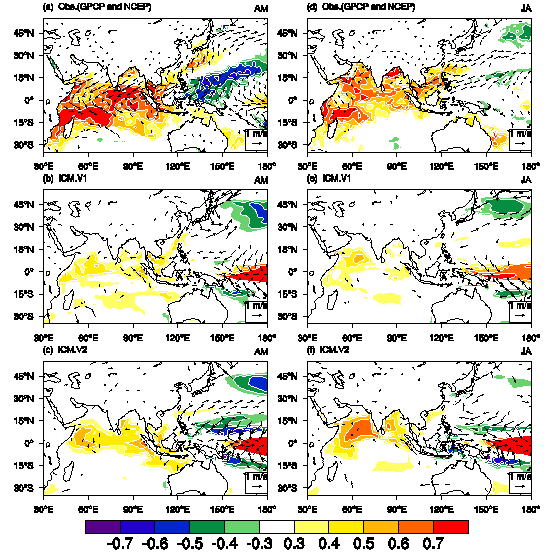Integrated Climate Model (ICM) is an atmosphere-ocean-sea ice coupled general model without flux adjustment developed at the Center for Monsoon System Research, Institute of Atmospheric Physics (CMSR/IAP), Chinese Academy of Sciences since 2008. This model integrates the Hamburg Atmospheric General Circulation Model Version 5 (ECHAM5) and the Nucleus for European Modeling of the Ocean Version 2.3 (NEMO 2.3) using the Ocean Atmosphere Sea Ice Soil Version 3 (OASIS3) as the coupler.
In order to improve the quality of model simulation, Professor HUANG Gang and his team have upgraded the atmospheric resolution of model from T31 (3.75o×3.75o) to T63 (1.8o×1.8o) and simulated El Ni?o-Southern Oscillation (ENSO) and East Asian-western North Pacific climate variability. The analyses are based on the last 100-year output of a 1000-year simulation. Results are compared to an earlier version of the same coupled model (ICM.V1). The two versions of ICM have the similar physics but different atmospheric resolution.
“The simulated climatological mean states show marked improvement over many regions, especially the tropics in ICM.V2 compared to those in ICM.V1.” said Prof. HUANG. “The common bias in the cold tongue has reduced and the warm biases along the ocean boundaries have improved as well.”

Correlation of April-May (AM) and July-August (JA) SST (colors) in the (a) observation, (b) ICM.V1 and (c) ICM.V2 with DJF(0) Nino3 index and regression of April-May (AM) and July-August (JA) 10m-winds (vectors; m/s) in the (d) observation, (e) ICM.V1 and (f) ICM.V2 with DJF(0) Ni?o3 index. (Image by IAP)
With improved simulation of ENSO, including its period and strength, the ENSO-related western North Pacific summer climate variability becomes more realistic compared to the observations. The simulated East Asian summer monsoon anomalies in the El Ni?o decaying summer are substantially more realistic in ICM.V2, which might be related to a better simulation of the Indo-Pacific Ocean capacitor (IPOC) effect and Pacific Decadal Oscillation (PDO).
The related contents have been published in Theoretical and Applied Climatology (2017).
Contact: HUANG Gang, hg@mail.iap.ac.cn
Liu, B., G. Zhao, G. Huang, P. Wang, and B. Yan, 2017: The dependence on atmospheric resolution of ENSO and related East Asian-western North Pacific summer climate variability in a coupled model.Theor Appl Climatol, doi:10.1007/s00704-017-2254-y. https://link.springer.com/article/10.1007/s00704-017-2254-y
